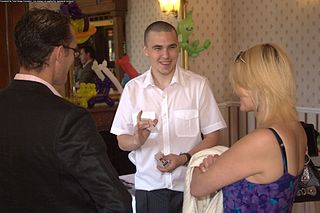Related Research Articles
Sleight of hand refers to fine motor skills when used by performing artists in different art forms to entertain or manipulate. It is closely associated with close-up magic, card magic, card flourishing and stealing. Because of its heavy use and practice by magicians, sleight of hand is often confused as a branch of magic; however, it is a separate genre of entertainment and many artists practice sleight of hand as an independent skill. Sleight of hand pioneers with worldwide acclaim include Dan and Dave, Ricky Jay, Derek DelGaudio, David Copperfield, Yann Frisch, Norbert Ferré, Dai Vernon, Cardini, Tony Slydini and Helder Guimarães.

Card manipulation is the branch of magic that deals with creating effects using sleight of hand techniques involving playing cards. Card manipulation is often used in magical performances, especially in close-up, parlor, and street magic. Some of the most recognized names in this field include Dai Vernon, Tony Slydini, Ed Marlo, S.W. Erdnase, Richard Turner, John Scarne, and Ricky Jay. Before becoming world-famous for his escapes, Houdini billed himself as "The King of Cards". Among the more well-known card tricks relying on card manipulation are Ambitious Card, and Three-card Monte, a common street hustle also known as Find the Lady.

Coin magic is the manipulating of coins to entertain audiences. Because coins are small, most coin tricks are considered close-up magic or table magic, as the audience must be close to the performer to see the effects. Though stage conjurers generally do not use coin effects, coin magic is sometimes performed onstage using large coins. In a different type of performance setting, a close-up coin magician will use a large video projector so the audience can see the magic on a big screen. Coin magic is generally considered harder to master than other close-up techniques such as card magic, as it requires great skill and grace to perform convincingly, and this requires much practice to acquire.
Second dealing is a method of manipulating a deck of cards during a card game by way of dealing the second, rather than the top card of the deck, usually for the purpose of cheating. Second dealing and bottom dealing are also used in performance magic.
A trick deck usually refers to a deck of playing cards that has been altered in some way to allow magicians to perform certain card tricks where sleight of hand would be too difficult or impractical.
Darwin Ortiz is a magician, who is an authority on gambling and card manipulation.
The Ambitious Card, or Elevator Card, is a magic effect in which a playing card seems to return to the top of the deck after being placed elsewhere in the middle of the deck. This is a classic effect in card magic and serves as a study subject for students of magic. Most performing card magicians will have developed their own personal Ambitious Card routine.
Bottom dealing or base dealing is a sleight of hand technique in which the bottom card from a deck of playing cards is dealt instead of the top card. It is used by magicians as a type of card illusion, and by card sharps and mechanics, and as a method of cheating in poker or other card games.
This is a glossary of conjuring terms used by magicians.
The gambler's palm is a card magic technique used to "palm" a card.

James "Mark" Wilson was an American magician and author, who was widely credited as the first major television magician and in the process establishing the viability of illusion shows as a television format.

Mark Wilson's Complete Course in Magic is a book on magic written by magician Mark Wilson. The book is a popular reference for magicians and has been in print since its first issue in 1975.

The Expert at the Card Table, is an extensive book on the art of sleight of hand published in 1902 by S. W. Erdnase, a pseudonymous author whose identity has remained a mystery for over a century. As a detailed manual of card sharps, the book is considered to be one of the most influential works on magic or conjuring with cards.
The Expert at the Card Table is the most famous, the most carefully studied book ever published on the art of manipulating cards at gaming tables."

Close-up magic is magic performed in an intimate setting usually no more than 3 meters from one's audience and is usually performed while sitting at a table.

Chink-a-chink is a simple close-up magic coin trick in which a variety of small objects, usually four, appear to magically transport themselves from location to location when covered by the performer's hands, until the items end up gathered together in the same place. Variations, especially the Sympathetic Coins also known as Coins-n-Cards, have been performed since the 1800s. Popular modern variations are Shadow Coins and Matrix. A variation using playing cards as the objects is known as Sympathetic Aces.
S. W. Erdnase is a pseudonym used by the author of The Expert at the Card Table, a book detailing sleight of hand, cheating and legerdemain using playing cards. Still considered essential reading for any card magician, the book has been in publication since 1902. Erdnase's true identity is one of the enduring mysteries of the magic community.

Magicana is a Canadian federally incorporated not-for-profit arts organization dedicated to the study, exploration and advancement of magic as a performing art. Magicana is governed by a volunteer Board of Directors. Julie Eng serves as Magicana's Executive Director and David Ben as its Artistic Director.

The art form of card flourishing, commonly referred to as cardistry, grew out of simple flourishes used in close-up magic by magicians in the 1990s to early 2000s. Chris Kenner's notable two-handed Sybil cut from his 1992 publication Totally Out of Control has carried great influence and gave birth to a series of advanced flourishes which today represents the foundation of the performance art. Sleight of hand pioneers Dan and Dave Buck popularized cardistry on the world stage with their instructional DVD releases from 2004 and 2007. Journalist Kevin Pang of Vanity Fair characterized the art of card flourishing as, "It's yo-yo tricks performed by cardsharps with the street cred of a Parkour video. There's a name for it: cardistry."
References
- ↑ "Amazing One Handed Top Palm Tutorial". Magic Pro Shop. Retrieved 2008-01-07.
- ↑ Wilson, Mark (1988) [1975]. Mark Wilson's Complete Course In Magic . Courage Books. ISBN 0-89471-623-9.The Classic Palm (Using a Coin), p. 190.
- ↑ Erdnase, S. W. (1995) [1902]. The Expert at the Card Table. Dover. ISBN 978-0-312-09771-4.Erdnase System of Palming, pp. 48-53.